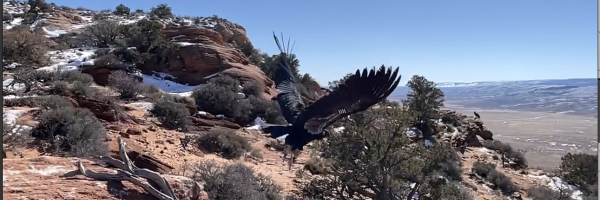BOISE, ID – Biologists from The Peregrine Fund successfully tagged California Condor number 1111, the second wild-hatched condor to fledge in Zion National Park. This condor represents the 1,111th condor identified since the recovery program began, and with the tagging, condor 1111 joins the monitored population, which currently has almost 350 condors flying free in the wild. His biological sibling 1K fledged Angel’s Landing in 2019. The Peregrine Fund is a member of The Southwest Condor Working Group that includes state wildlife agencies of Utah and Arizona, federal partners including Grand Canyon and Zion National Parks, U.S. Fish and Wildlife Service, Bureau of Land Management, and National Forest Service.
California Condor 1111 hatched April 16, 2021 in Zion National Park near Angel’s Landing and successfully fledged on August 28, 2021. 1111 is one of five wild fledges in the population from 2021. Janice Stroud-Settles, Zion National Park Wildlife Program Manager is enthusiastic about this second wild bird. "Having a wild-fledged condor for the second time in Zion National Park not only highlights the steady growth of wild-bred condors in the Southwest condor population, but also exhibits the outstanding condor habitat in and surrounding Zion."
The young condor first arrived at the trapping location in northern Arizona at Vermilion Cliffs National Monument on May 18, 2022, but biologists were not able to identify the bird without any potential parents present.
“Not knowing which of the five wild fledges we had trapped was certainly a challenge! With the help of a transmitter and a temporary ID tag, we knew it wouldn’t take long to solve this mystery. Within days, biologists in Zion National Park tracked the youngster to Angel's Landing, and not long after the pictures started to show up on social media,” remarked The Peregrine Fund’s California Condor Reintroduction Program Director, Tim Hauck, on successfully identifying Condor 1111.
Eight and a half months later, on Monday, February 6, 2023, 1111 arrived back at the trap in Arizona.“To be able to have 1111 in hand and know that it is thriving and healthy gives me great hope that the future of the species is bright. A true success story in the making”, recalls Hauck, “but our work is far from over.”
Hauck and his team properly tagged 1111 and, after a successful health check, released the bird back into the wild. Despite the intensive reintroduction work by The Peregrine Fund and federal and state agency partners since 1996, each individual bird is of vital importance to the full recovery of the species. Lead poisoning accounts for 50% of diagnosed deaths for free-flying populations of condors. Tags, transmitters, and GPS units allow biologists to monitor movement patterns, determine food sources, assess overall health, and recover birds for diagnosis should they die in the wild.
The good news is that hunters are stepping up to lead this conservation effort. In 2005, Arizona Game and Fish Department began offering free non-lead ammunition to northern Arizona hunters, and in 2008, Utah Department Wildlife Resources initiated a similar program in the southern Utah condor range. For over a decade, at least 85% of hunters on the Kaibab Plateau voluntarily used non-lead ammunition or removed remains from the field. Utah is not far behind with 80% participation in their non-lead program. "We are encouraged by the support that our hunters have shown thus far, and expect that they will continue to support and spread the word about condor conservation and the benefits of non-lead ammunition," says Danielle Finlayson, Utah’s Department of Natural Resources Conservation Species Biologist.
The programs in Arizona and Utah have helped pave the path of the North American Non-lead Partnership, co-founded by The Peregrine Fund, to expand the use of non-lead ammunition for the benefit of scavenging raptors and to support healthy ecosystems for all wildlife. Jeremy Hanks, who recently helped shepherd legislation in Utah to name the Golden Eagle as their state’s bird of prey, was there to witness the tagging of 1111. “Seeing 1111, with its nearly 10-foot wingspan, take flight after receiving its official tag was awesome! The work The Peregrine Fund does to engage with hunters on ammunition options will help California Condors and Golden Eagles and create healthier landscapes for everyone to enjoy. I hope I'm alive to see number 11,111 fledge into the wild!”
Not far from Angel’s Landing in Zion National Park, 1111’s parents are being closely monitored by biologists with the enthusiastic hope that any day now they will lay another egg. A third successful wild-fledge from this pair would be one more milestone in the effort to save this iconic North American species. “Only 25 years ago we wondered if condors would ever breed again in the wild. And now here we are not only watching these birds survive, but taking great pride in how they are thriving,” says Hauck.
For more information on the lead issue, and who is supporting this growing movement, visit the North American Non-lead Partnership at www.nonleadpartnership.org or www.huntingwithnonlead.org.
For more information on the California Condor Recovery Program, visit: http://www.peregrinefund.org/projects/california-condor.
California Condor Recovery Program | U.S. Fish & Wildlife Service (fws.gov)
The Southwest Working Group is part of a larger California Condor recovery effort led by the U.S. Fish and Wildlife Service. The California Condor Recovery Program is a shining example of how a species can be brought back from the brink of extinction through the power of partnerships including federal, state, Tribes, NGOs, and even other countries with the partnership of Mexico.







